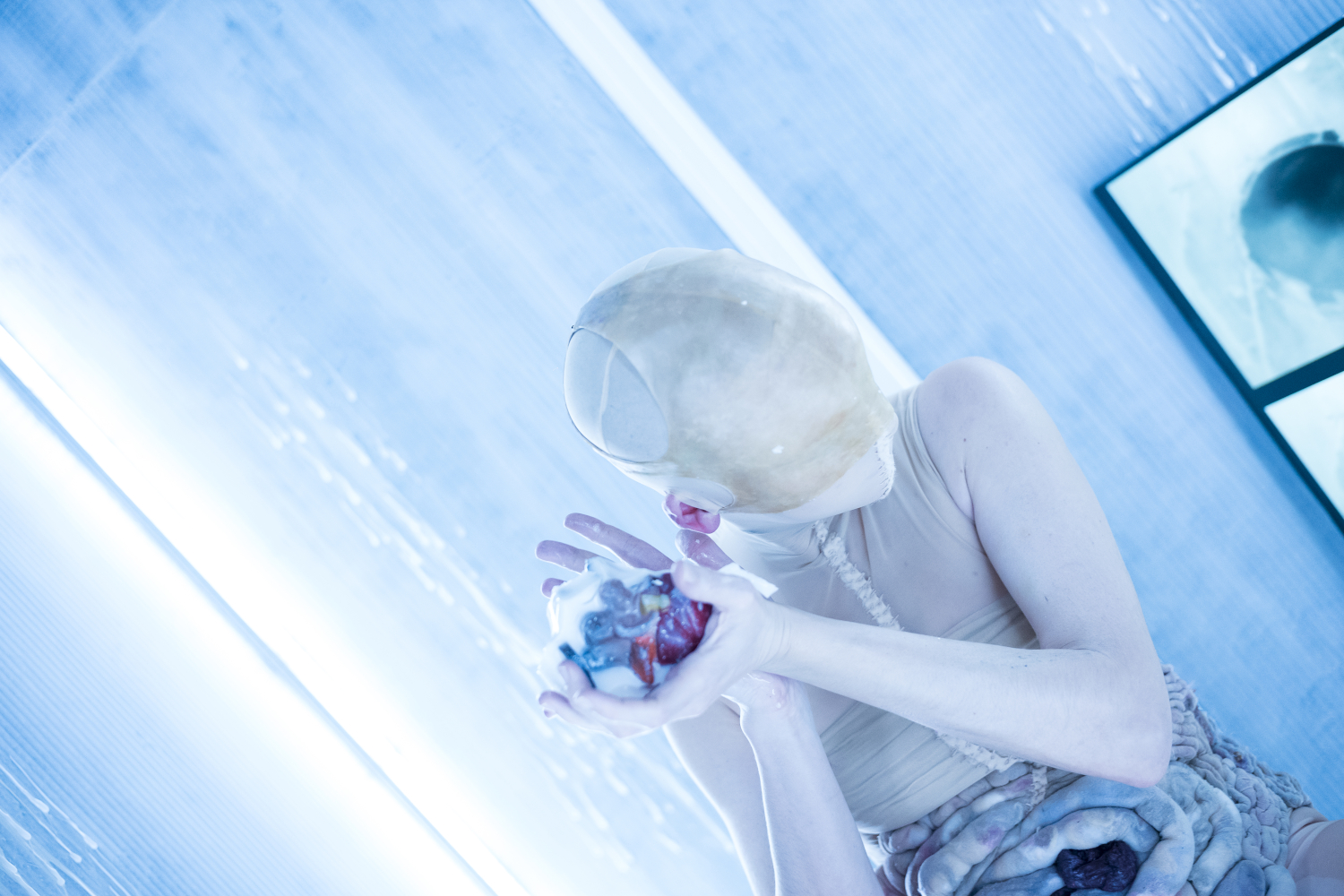Text by Ania Mokrzycka
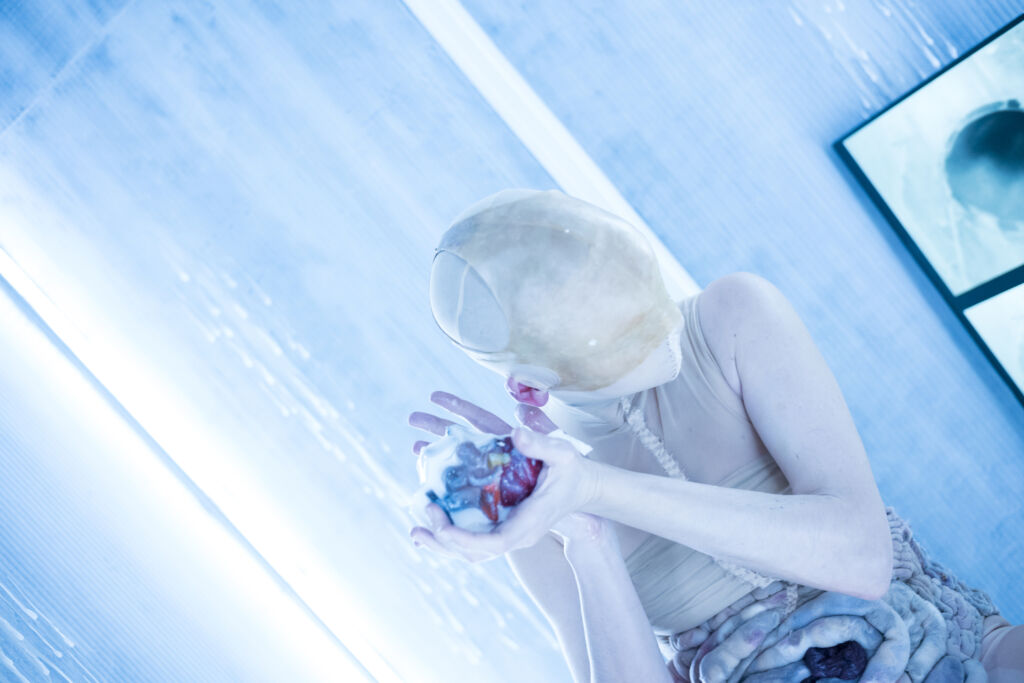
An ever-changing and permeable configuration of ideas, agencies and knowledge, Fronte Vacuo could be defined as a radical exercise in interdisciplinarity and collaboration. Composed of three artists who met in Berlin in 2014, it manifests the idea of a whole that is more than the sum of its parts. Margherita Pevere, Marco Donnarumma and Andrea Familari, each operating within distinct aesthetic registers and equipped with varied sets of skills, brought their diverse practices together in 2019, united by the need to “create something that would speak to the immense complexity of today’s crises (social, techno-capitalistic, ecological)”. They conceived Fronte Vacuo, from the Italian “fronte” denoting a military or political front, and “vacuo” as something vacuous, without contents, empty; a militant proposition for alternative artistic languages capable of responding and acting upon our anguished realities.
Defying boundaries between disciplines and infiltrating different contexts, Fronte Vacuo crosses over from new media art into dance and theatre, while absorbing elements from body art, bio art, video art and sound art. They create multisensory experiences and installations varying in scale and duration, incorporating emerging technologies, living organisms, sound and video. Each artist has their own expertise, but as they describe it, they are entangled with one another (…); it’s not like a puzzle where there is only one way of fitting the pieces together. Ideas mesh with one another; somebody may develop things further and then pass them on (…) We try to get the best out of each other’s skills by provoking our thoughts to collide in interesting ways.
Immersed in continuous experimentation and mutual activation, the artists find the essence of their project at this unstable point of friction. Further collaborators, working in disciplines ranging from stage design, wearable sculpture and computer science to cultural studies and architecture, continue to bring new elements to the works and their reiterations.
No role, form, material or relation remains known and settled; instead, they are continuously composed and recomposed in pursuit of unpredictable interaction: Our practice taught us to think ‘through’ the combination of various media. Each material – be it live sound and video, AI or water – has its own ‘agency’ and poetics. So, what we do is to magnify the intrinsic poetics of each material, and put them under a huge lens so that the tiniest feature becomes a world to immerse yourself in.
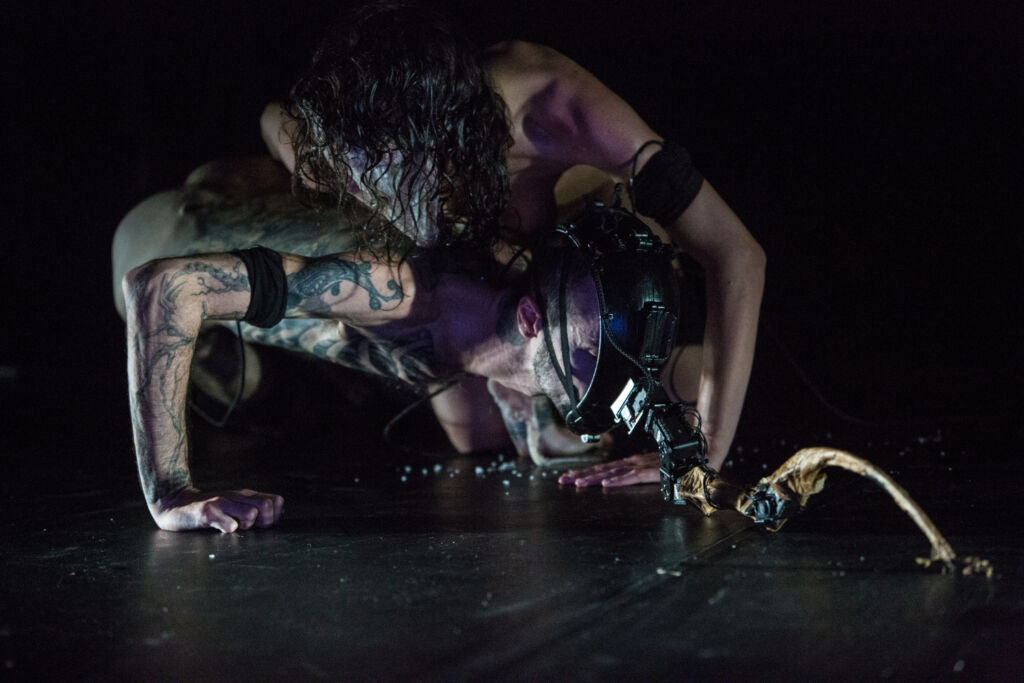
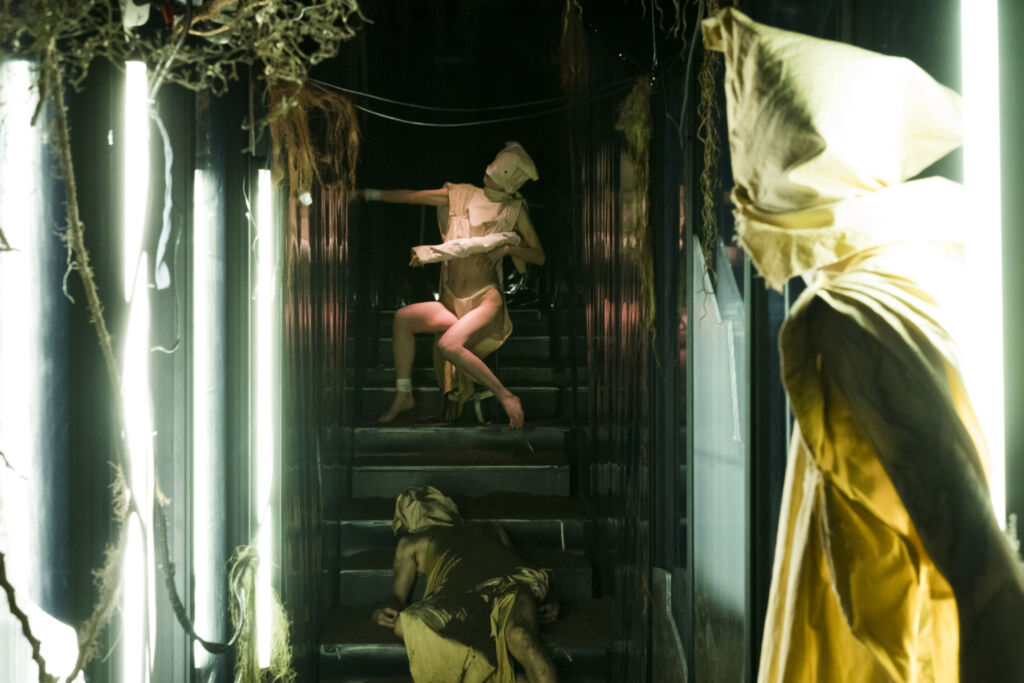
While this restless accumulation of interconnected layers is their way of reflecting on the current times, the artists believe in the importance of creating a cohesive narrative that can assist audiences in navigating the complex world of Fronte Vacuo. Humane Methods is an ongoing, long-term series of works telling stories of a broken society reemerging from a ruinous futuristic past, where verbal communication is replaced by algorithmic languages. If it sounds like a possible dystopian scenario for our society, it’s because it is exactly that. In this sense, Humane Methods is embodied science fiction.
Its characters, enlivened with an array of their own symbols, myths and hierarchies, are hybrid creatures enclosed in meticulously constructed, immersive environments into which the audiences are drawn involuntarily. “Combining this approach with intense body performance and interactive technology allows us to create sort of social experiments where we can test – collectively, with the audience – questions of responsibility, agency, morality and exploitation,” explains Fronte Vacuo.
The new chapter of Humane Methods, 6XXX6, consists of six pieces, or “movements”, to be performed in six different places between 2022 and 2024 as part of the Volkstheater Wien residency. Invited by the theatre’s director, Kay Voges, Fronte Vacuo are working in close collaboration with Volkstheater’s team and ensemble, as well as a visionary set designer Anna Cingi. Each of the 6 pieces is a site-specific work varying in scale and format and happening across different spaces within and outside of the theatre: “You could think of it as the Humane Methods world invading the theatre,” they explain.
Working within a national theatre context creates new possibilities, from expanding the scope of the project and really testing innovative solutions to widening their audiences. While preserving their artistic and aesthetic independence, what Fronte Vacuo values most is, yet again, the exchange – this time with Kay Voges and the theatre’s team: the possibility to interface independent performance-making with the creative work of a national level institution (…) Volkstheater Wien is proving itself as one of the most daring European national theatres today, so our collaboration is a chance for us to develop a new artistic language without much constraint, they tell us when asked about the residency.
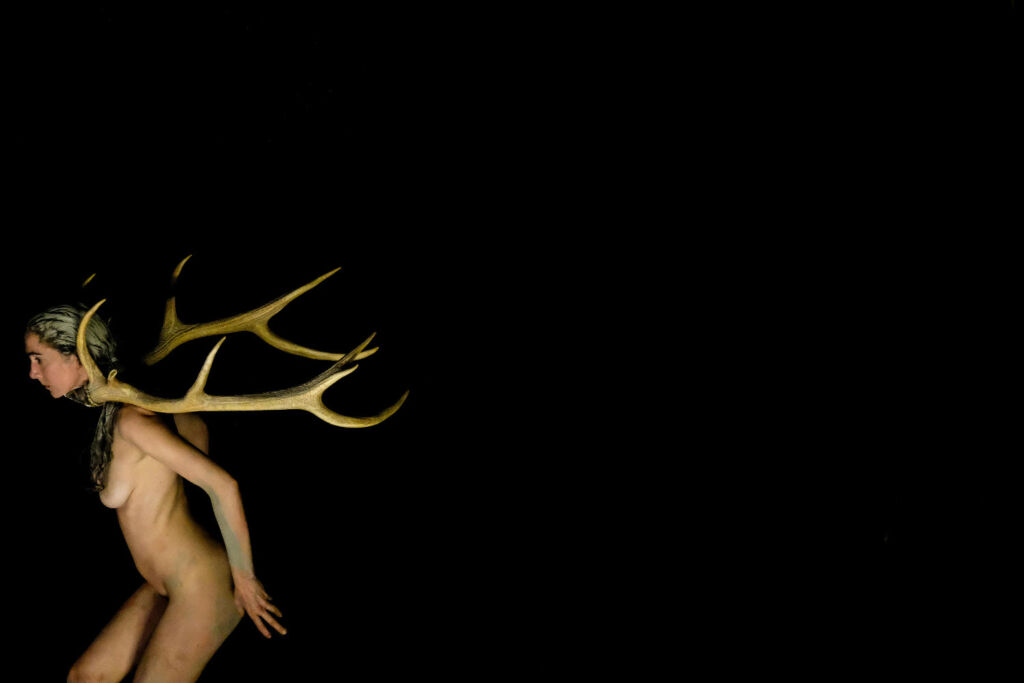
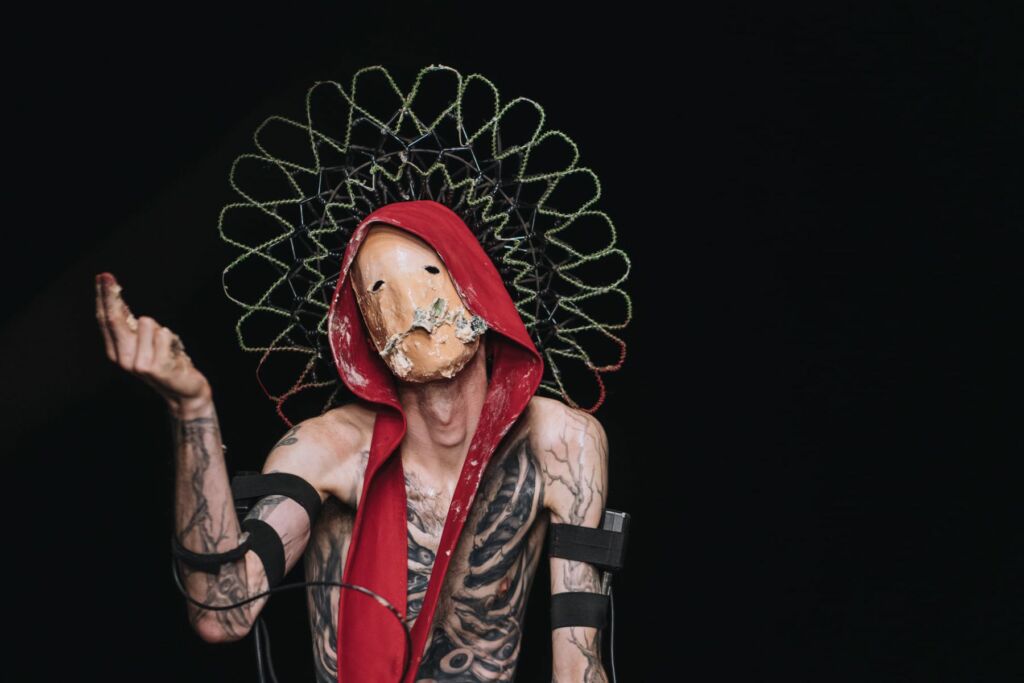
The first ‘movement’ of 6XXX6, titled δISSOLUTION, took place in November 2022 and will be followed by ¦MPOSSIBILITY, premiering on the 24th of March. With each new piece, the ‘posthuman mythology’ of Humane Methods grows and expands. Its characters, reappearing in different reiterations, shift and evolve as their stories become more intricate and compelling.
δISSOLUTION, directed by Pevere and involving two performers – the Oracle and the Officiant, an AI audiovisual system called <dmb> and a small group of participants, offered an intimate, sensual experience of an uncanny archive, ‘the dissolution room’ where the only surviving objects from the ‘Old World’ are stored. The Officiant, a character known from their previous work, ℧R, transforms from a solitary and aggressive character into one that seeks contact and interaction. The Oracle, a genderless, sensual, but mischievous entity enclosed in a cage, surveils the whole space, having grown organs outside the limits of its skin.
The viewers become participants upon entering the room and embark on a ritualistic process of memory retrieval, observing and exploring the objects and the performers’ bodies through touch and direct interaction. The ambience of the space (vibrating sound, lighting and video imagery) is generated by a <dmb> system gathering and processing data from the viewers’ eye scan. <dbm>, an algorithmic performer, is omnipresent but cannot be seen; its precise actions and behaviours are indecipherable to most audiences. Fronte Vacuo compares <dmb> to the wind: one does not see the wind but can perceive it in its interaction with other things. Like the wind that shapes a particular mood in a landscape by shaking trees and brushing one’s body, <dmb> steers the narrative of Humane Methods in response to the other characters and the audience.
Fronte Vacuo offers radical but poetic reflections upon the climate crisis, intergenerational memory, abjection, inaction, voyeurism and exploitation. Drawing the audiences deep into their world built on an incredibly expanded, complex and ever-evolving system of symbols, metaphors, myths, colours, rituals and immersive environments, they fulfil a shared need for cathartic experiences. The strength of the project stems from their coming together and generating new potentialities for artistic expression. In their own words, Fronte Vacuo is a challenging and rewarding journey, and, maybe, most importantly, a great learning experience in collaborative creation.
Check Fronte Vacuo‘s upcoming performances here.

